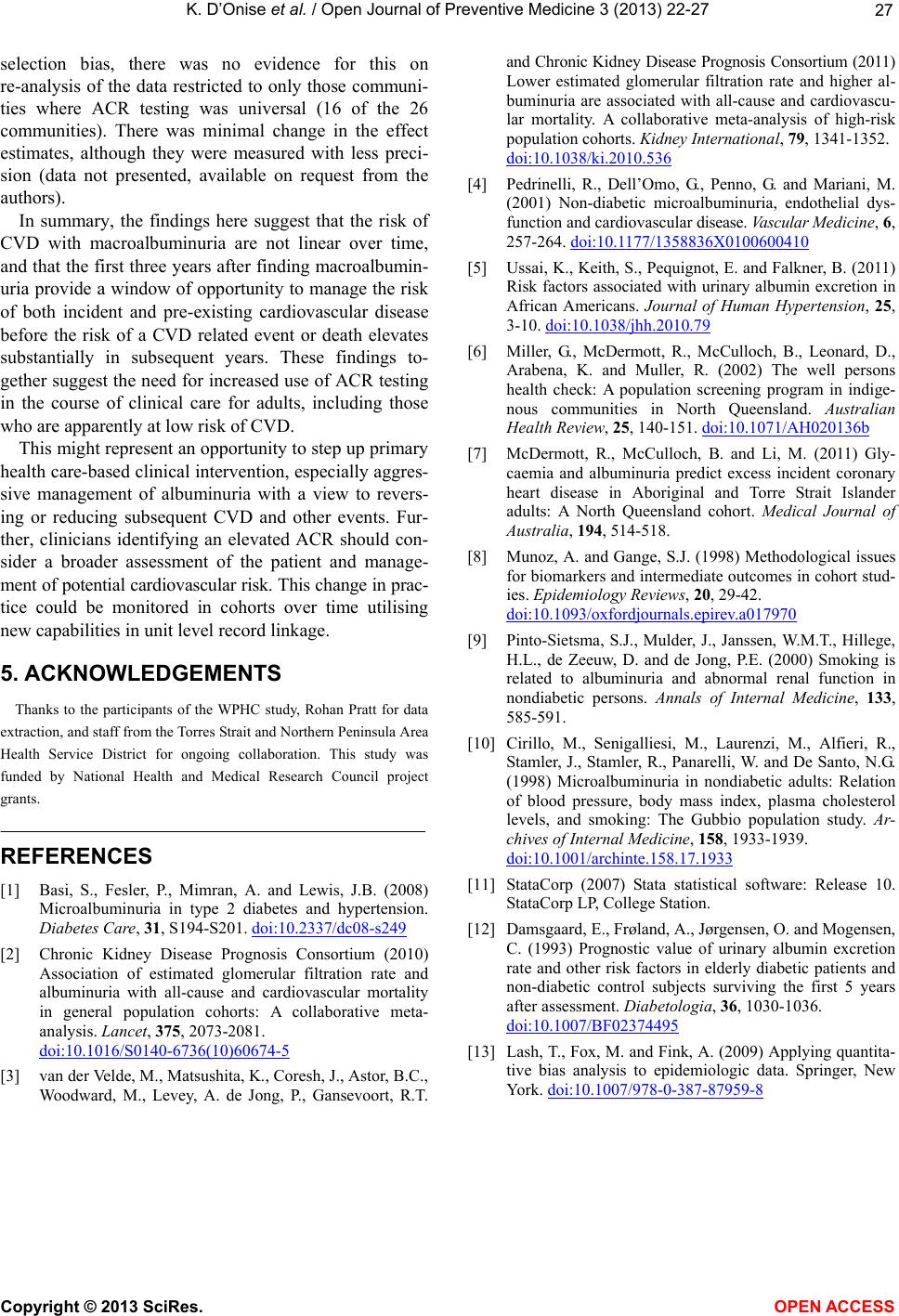
K. D’Onise et al. / Open Journal of Preventive Medicine 3 (2013) 22-27 27
selection bias, there was no evidence for this on
re-analysis of the data restricted to only those communi-
ties where ACR testing was universal (16 of the 26
communities). There was minimal change in the effect
estimates, although they were measured with less preci-
sion (data not presented, available on request from the
authors).
In summary, the findings here suggest that the risk of
CVD with macroalbuminuria are not linear over time,
and that the first three years after finding macroalbumin-
uria provide a window of opportunity to manage the risk
of both incident and pre-existing cardiovascular disease
before the risk of a CVD related event or death elevates
substantially in subsequent years. These findings to-
gether suggest the need for increased use of ACR testing
in the course of clinical care for adults, including those
who are apparently at low risk of CVD.
This might represent an opportunity to step up primary
health care-based clinical intervention, especially aggres-
sive management of albuminuria with a view to revers-
ing or reducing subsequent CVD and other events. Fur-
ther, clinicians identifying an elevated ACR should con-
sider a broader assessment of the patient and manage-
ment of potential cardiovascular risk. This change in prac-
tice could be monitored in cohorts over time utilising
new capabilities in unit level record linkage.
5. ACKNOWLEDGEMENTS
Thanks to the participants of the WPHC study, Rohan Pratt for data
extraction, and staff from the Torres Strait and Northern Peninsula Area
Health Service District for ongoing collaboration. This study was
funded by National Health and Medical Research Council project
grants.
REFERENCES
[1] Basi, S., Fesler, P., Mimran, A. and Lewis, J.B. (2008)
Microalbuminuria in type 2 diabetes and hypertension.
Diabetes Care, 31 , S194-S201. doi:10.2337/dc08-s249
[2] Chronic Kidney Disease Prognosis Consortium (2010)
Association of estimated glomerular filtration rate and
albuminuria with all-cause and cardiovascular mortality
in general population cohorts: A collaborative meta-
analysis. Lancet, 375, 2073-2081.
doi:10.1016/S0140-6736(10)60674-5
[3] van der Velde, M., Matsushita, K., Coresh, J., Astor, B.C.,
Woodward, M., Levey, A. de Jong, P., Gansevoort, R.T.
and Chronic Kidney Disease Prognosis Consortium (2011)
Lower estimated glomerular filtration rate and higher al-
buminuria are associated with all-cause and cardiovascu-
lar mortality. A collaborative meta-analysis of high-risk
population cohorts. Kidney International, 79, 1341-1352.
doi:10.1038/ki.2010.536
[4] Pedrinelli, R., Dell’Omo, G., Penno, G. and Mariani, M.
(2001) Non-diabetic microalbuminuria, endothelial dys-
function and cardiovascular disease. Vascular Medicine, 6,
257-264. doi:10.1177/1358836X0100600410
[5] Ussai, K., Keith, S., Pequignot, E. and Falkner, B. (2011)
Risk factors associated with urinary albumin excretion in
African Americans. Journal of Human Hypertension, 25,
3-10. doi:10.1038/jhh.2010.79
[6] Miller, G., McDermott, R., McCulloch, B., Leonard, D.,
Arabena, K. and Muller, R. (2002) The well persons
health check: A population screening program in indige-
nous communities in North Queensland. Australian
Health Review, 25, 140-151. doi:10.1071/AH020136b
[7] McDermott, R., McCulloch, B. and Li, M. (2011) Gly-
caemia and albuminuria predict excess incident coronary
heart disease in Aboriginal and Torre Strait Islander
adults: A North Queensland cohort. Medical Journal of
Australia, 194, 514-518.
[8] Munoz, A. and Gange, S.J. (1998) Methodological issues
for biomarkers and intermediate outcomes in cohort stud-
ies. Epidemiology Reviews, 20, 29-42.
doi:10.1093/oxfordjournals.epirev.a017970
[9] Pinto-Sietsma, S.J., Mulder, J., Janssen, W.M.T., Hillege,
H.L., de Zeeuw, D. and de Jong, P.E. (2000) Smoking is
related to albuminuria and abnormal renal function in
nondiabetic persons. Annals of Internal Medicine, 133,
585-591.
[10] Cirillo, M., Senigalliesi, M., Laurenzi, M., Alfieri, R.,
Stamler, J., Stamler, R., Panarelli, W. and De Santo, N.G.
(1998) Microalbuminuria in nondiabetic adults: Relation
of blood pressure, body mass index, plasma cholesterol
levels, and smoking: The Gubbio population study. Ar-
chives of Internal Medicine, 158, 1933-1939.
doi:10.1001/archinte.158.17.1933
[11] StataCorp (2007) Stata statistical software: Release 10.
StataCorp LP, College Station.
[12] Damsgaard, E., Frøland, A., Jørgensen, O. and Mogensen,
C. (1993) Prognostic value of urinary albumin excretion
rate and other risk factors in elderly diabetic patients and
non-diabetic control subjects surviving the first 5 years
after assessment. Diabetologia, 36, 1030-1036.
doi:10.1007/BF02374495
[13] Lash, T., Fox, M. and Fink, A. (2009) Applying quantita-
tive bias analysis to epidemiologic data. Springer, New
York. doi:10.1007/978-0-387-87959-8
Copyright © 2013 SciRes. OPEN ACCE SS